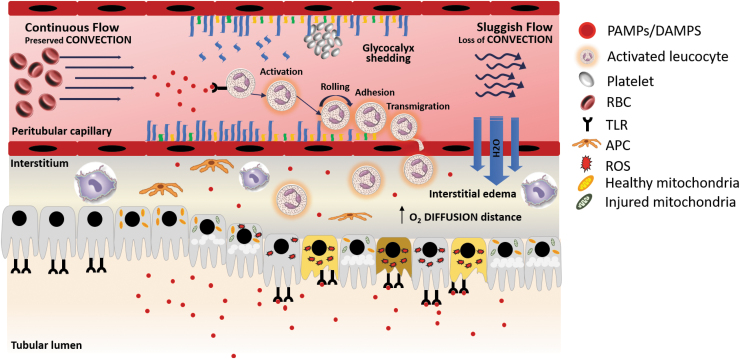FIG. 4.
Inflammatory response and microcirculatory dysfunction in AKI. PAMPs and DAMPs are inflammatory mediators derived from bacteria and host immune cells, respectively. These inflammatory mediators bind to PRRs expressed on the surface of innate immune cells, endothelial cells, and renal TECs initiating a downstream cascade of signals that will increase the synthesis of proinflammatory cytokines, ROS, oxidative stress, and endothelial activation by nitric oxide and iNOS upregulation. During inflammation, DAMPs and PAMPs are filtered in the glomeruli. Once in the tubule these are going to bind the TLRs present in the apical membrane of the TECs. In addition, some evidence suggests that TECs are also exposed to the inflammatory mediators that are present in the peritubular circulation, although the mechanisms of how this occurs are not still clear. Moreover, the inflammatory response can also injure the TECs by increasing the oxidative stress and producing ROS. Microcirculatory dysfunction is the result of a series of events that lead to an impaired delivery of oxygen and nutrients to the tissue. Endothelial activation provoked by the inflammatory response results in a cascade of events that lead to shedding of the glycocalyx, increased leukocyte migration, and endothelial permeability. In addition, microcirculatory dysfunction is characterized by a heterogeneous flow, reduced number of capillaries with continuous flow with an associated increase of capillaries with sluggish flow, or no flow. Sluggish flow and no flow, result of the increased expression of adhesion molecules on the inflammatory and endothelial cells, facilitate the migration of neutrophils and macrophage to the interstitial space. Furthermore, the areas with sluggish flow have increased production of ROS and oxidative stress. Manifested by TEC apical vacuolization (31, 32, 34). DAMP, damage-associated molecular patterns; iNOS, inducible nitric oxide synthase; PAMP, pathogen-associated molecular pattern; PRRs, pattern recognition receptors; ROS, reactive oxygen species; TLRs, toll-like receptors.

